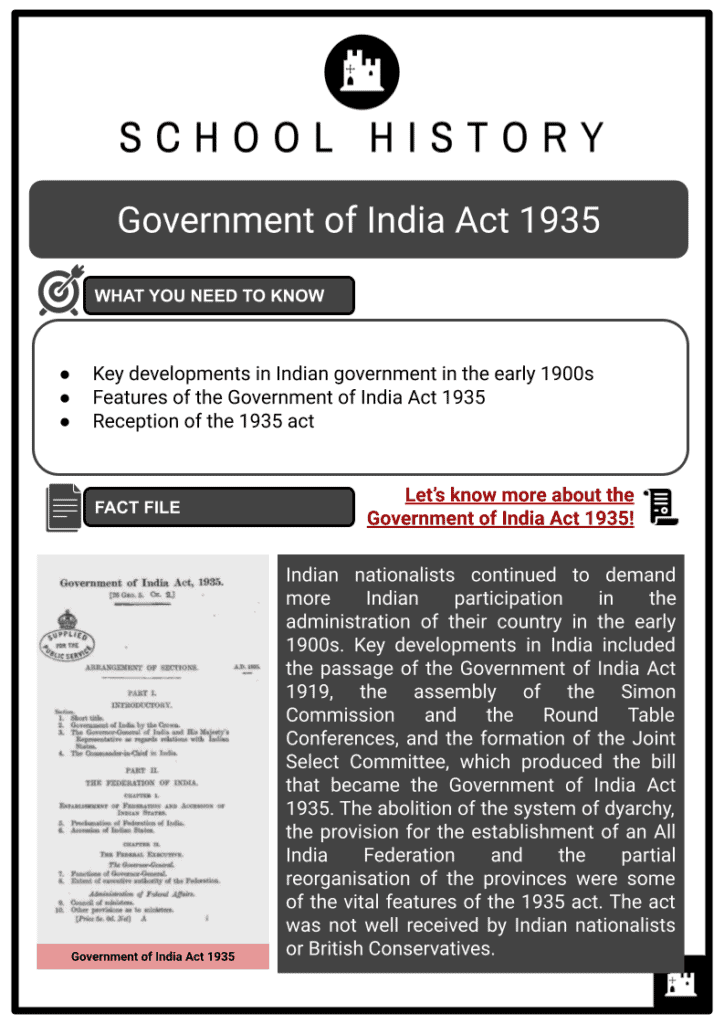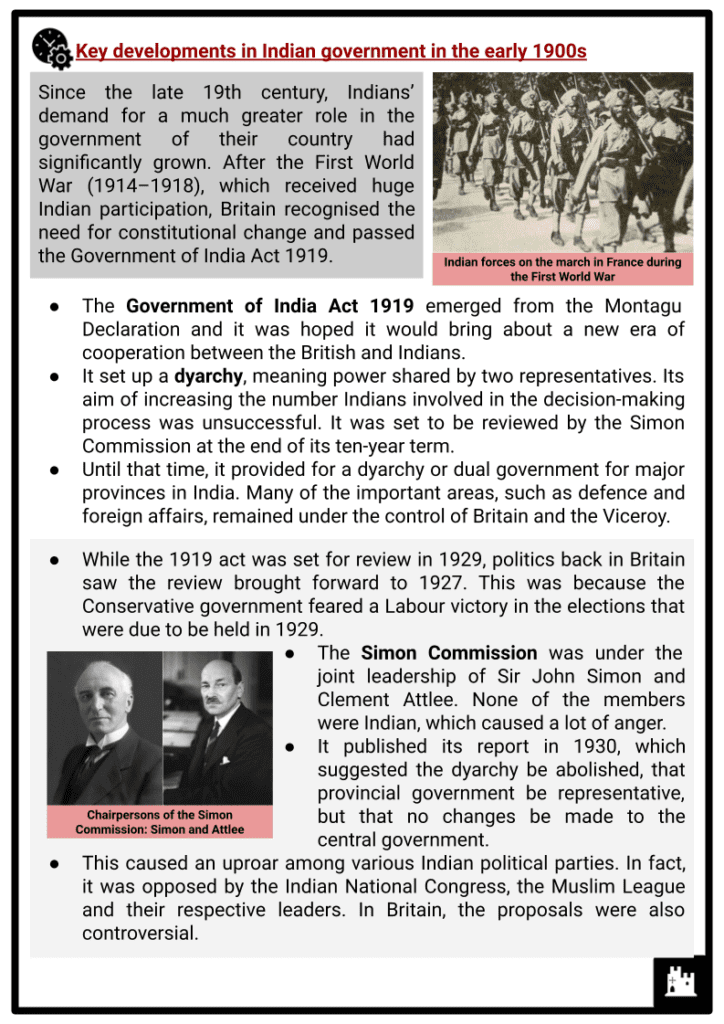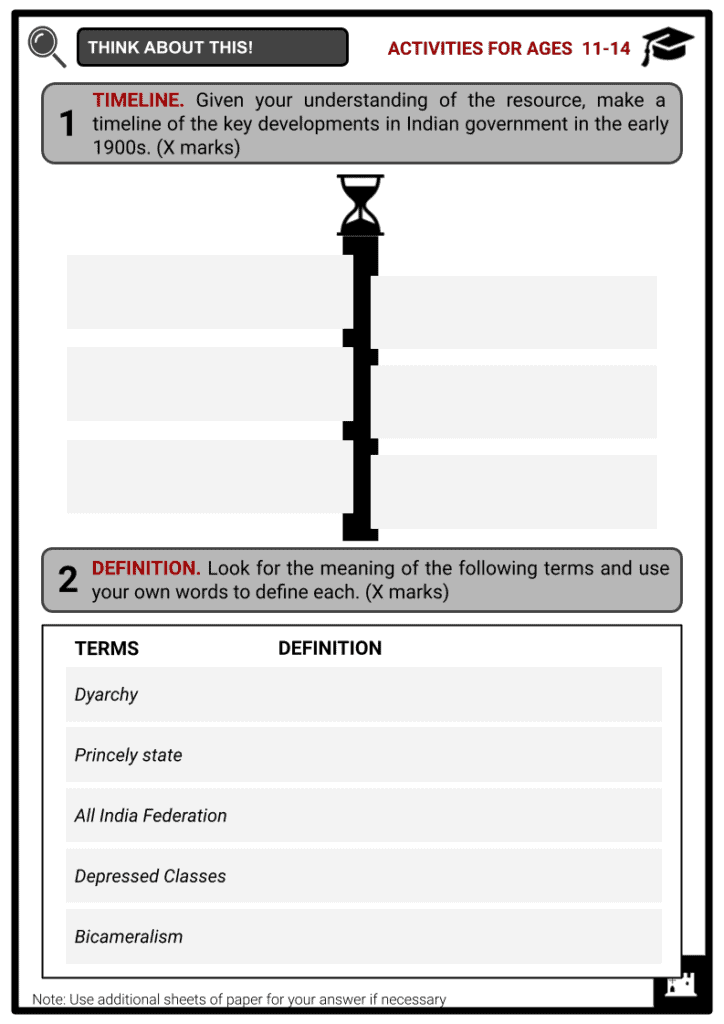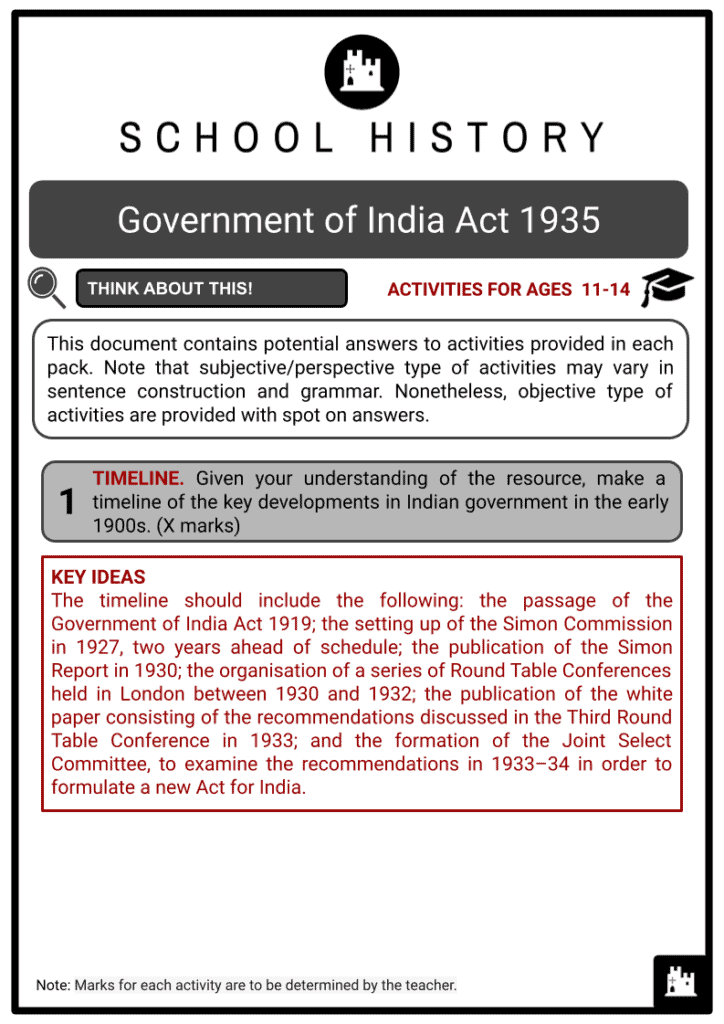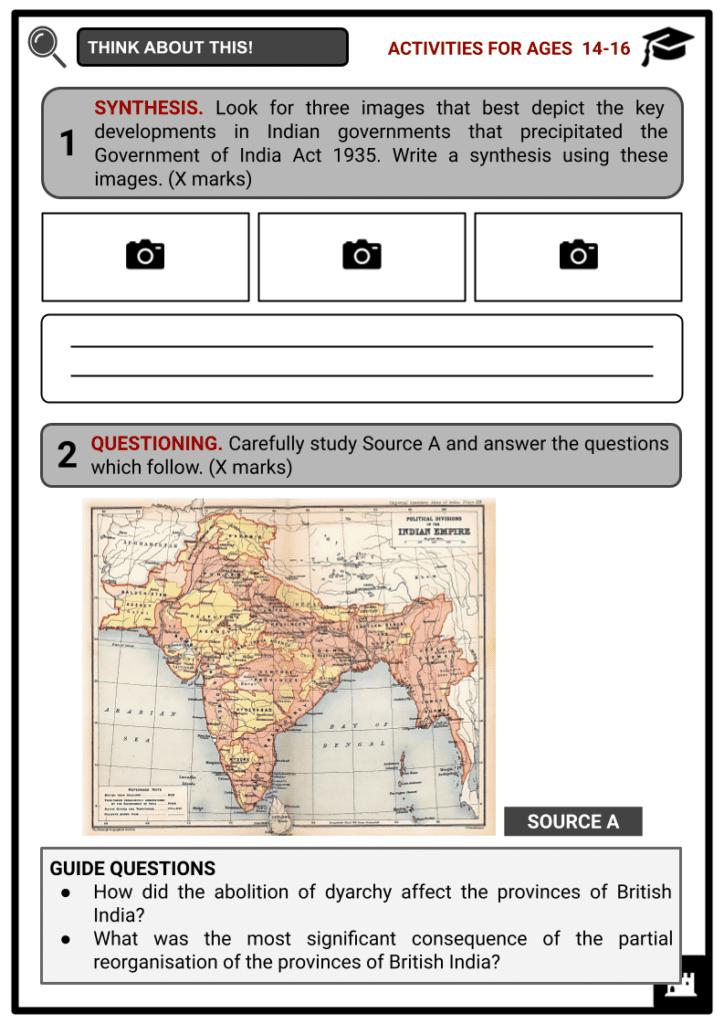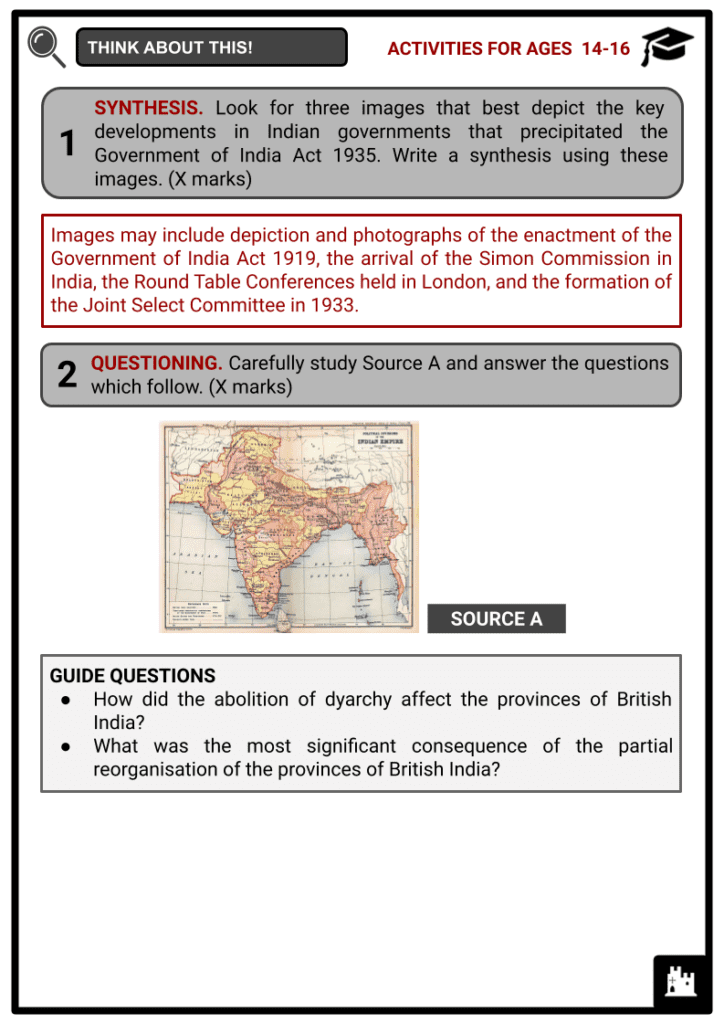Government of India Act 1935 Worksheets
Do you want to save dozens of hours in time? Get your evenings and weekends back? Be able to teach about the Government of India Act 1935 to your students?
Our worksheet bundle includes a fact file and printable worksheets and student activities. Perfect for both the classroom and homeschooling!
Summary
- Key developments in Indian government in the early 1900s
- Features of the Government of India Act 1935
- Reception of the 1935 act
Key Facts And Information
Let’s know more about the Government of India Act 1935!
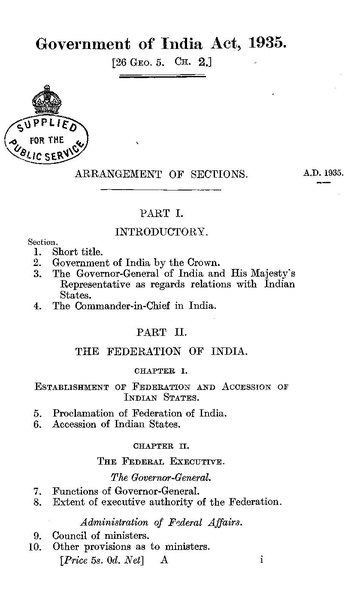
Indian nationalists continued to demand more Indian participation in the administration of their country in the early 1900s. Key developments in India included the passage of the Government of India Act 1919, the assembly of the Simon Commission and the Round Table Conferences, and the formation of the Joint Select Committee, which produced the bill that became the Government of India Act 1935. The abolition of the system of dyarchy, the provision for the establishment of an All India Federation and the partial reorganisation of the provinces were some of the vital features of the 1935 act. The act was not well received by Indian nationalists or British Conservatives.
Key developments in Indian government in the early 1900s
- Since the late 19th century, Indians’ demand for a much greater role in the government of their country had significantly grown. After the First World War (1914–1918), which received huge Indian participation, Britain recognised the need for constitutional change and passed the Government of India Act 1919.
- The Government of India Act 1919 emerged from the Montagu Declaration and it was hoped it would bring about a new era of cooperation between the British and Indians.
- It set up a dyarchy, meaning power shared by two representatives. Its aim of increasing the number Indians involved in the decision-making process was unsuccessful. It was set to be reviewed by the Simon Commission at the end of its ten-year term.
- Until that time, it provided for a dyarchy or dual government for major provinces in India. Many of the important areas, such as defence and foreign affairs, remained under the control of Britain and the Viceroy.
- While the 1919 act was set for review in 1929, politics back in Britain saw the review brought forward to 1927. This was because the Conservative government feared a Labour victory in the elections that were due to be held in 1929.
- The Simon Commission was under the joint leadership of Sir John Simon and Clement Attlee. None of the members were Indian, which caused a lot of anger.
- It published its report in 1930, which suggested the dyarchy be abolished, that provincial government be representative, but that no changes be made to the central government.
- This caused an uproar among various Indian political parties. In fact, it was opposed by the Indian National Congress, the Muslim League and their respective leaders. In Britain, the proposals were also controversial.
- Precipitated by the report of the Simon Commission, a series of Round Table Conferences was organised by the British government and the Congress.
- Held between 1930 and 1932 in London, the aim of the conferences was to discuss constitutional reforms in India. Representatives from India’s main political parties and the princely states attended them at times.
- Several issues were discussed and there was an understanding in principle that an all-India federation should be established to take care of most matters in the country.
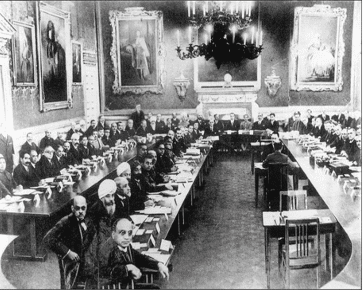
First Round Table Conference - However, no final agreement was made owing to the division between Congress and Muslim representatives.
- The recommendations discussed in the Third Round Table Conference were published in a white paper entitled Proposals for Indian Constitutional Reform in March 1933. It was debated in Parliament amid much opposition from backbench Conservatives.
- A Joint Select Committee, chaired by Lord Linlithgow, analysed the recommendations between April 1933 and November 1934 in order to formulate a new Act for India.
Features of the Government of India Act 1935
- The Joint Select Committee in Britain produced a draft bill in February 1935 based on the white paper published in 1933. The bill received royal assent in August as the Government of India Act 1935. It came into force in July 1937.
What were the significant aspects of the act?
- The granting of a large measure of autonomy to the provinces of British India, abolishing the system of dyarchy
- The governor was the head of the executive, with a council of ministers to advise him.
- The degree of autonomy introduced at the provincial level, however, was subject to important limitation as the provincial governors retained special reserve powers, and the British authorities could still suspend a provincial government.
- Provision for the establishment of an All India Federation to be made up of both British India and some or all of the princely states
- The provinces would have to join the federation but this was not compulsory for the princely states.
- This federation never materialised due to the lack of support from rulers of the princely states.
- Introduction of direct elections for the first time
- This increased the franchise from seven million to 35 million people.
- A partial reorganisation of the provinces
- Sindh was separated from Bombay.
- Bihar and Orissa was split into separate provinces of Bihar and Orissa.
- Burma was cut off from India.
- Aden was also detached from India, and established as a separate Crown colony.
- The grant of separate electorates for minority communities, excluding the Depressed Classes (marginalised section)
- Provision for the adoption of dyarchy at the centre
- Key subjects like defence and foreign affairs were under the direct control of the Governor-General. This clause did not come into effect.
- Establishment of a bicameral federal legislature
- The two houses were the Federal Assembly (lower house) and the Council of States (upper house).
- Bicameralism was introduced in six provinces: Bengal, Madras, Bombay, Bihar, Assam and the United Provinces.
- Creation of a federal court
- A federal court was established at Delhi for the resolution of disputes between provinces and also between the centre and the provinces.
The Government of India Act 1935 also provided for the establishment of the Federal Railway Authority, the Reserve Bank of India, as well as the federal, provincial and joint Public Service Commissions.
Reception of the 1935 act
- In Britain, the diehards, particularly Winston Churchill, denounced the passage of the 1935 act. Similarly, in India, the act was not well received. No significant party accepted the federal portion of the act.
Congress
- Congress rejected the act because they wanted an independent home state with a strong central government.
- Members were not interested in what they saw as a halfway solution.
- They also feared a Muslim domination in new provincial assemblies.
Muslim League
- The Muslim League rejected the act because they argued that no significant power was given to Muslims.
- They had concerns that Hindus would not guarantee the rights of minorities.
- Muhammad Ali Jinnah called the act ‘fundamentally bad and totally unacceptable.’
Princely states
- The proposed All India Federation would diminish the power of princes. In fact, the British government warned not to force the princes as this might lead them to join the diehards.
- The princes rejected this proposal en masse.
- Many princes wanted to continue to rule their states without interference.
- The new Viceroy of India, Lord Linlithgow, was given the responsibility of bringing the act into effect. He attempted tirelessly to launch the federation with the accession of the princes. However, with the princes’ rejection of this proposal en masse, the federation never pushed through.
- While the act marked the second milestone towards an entirely responsible government in India after the 1919 act, its passage became responsible for creating irreparable divisions between Congress and the Muslim League.
Image Sources
- https://upload.wikimedia.org/wikipedia/commons/thumb/9/93/Government_of_India_Act_1935.pdf/page1-357px-Government_of_India_Act_1935.pdf.jpg?20200517113326
- https://upload.wikimedia.org/wikipedia/commons/e/e7/The_First_Round_Table_Conference_was_inaugurated_by_King_George-V_on_Nov.12%2C_1930_in_London%2C_Dr_Babasaheb_Ambedkar%2C_Delegate%2C_seen_in_the_left_row_%289th%29.png?20170531020506

